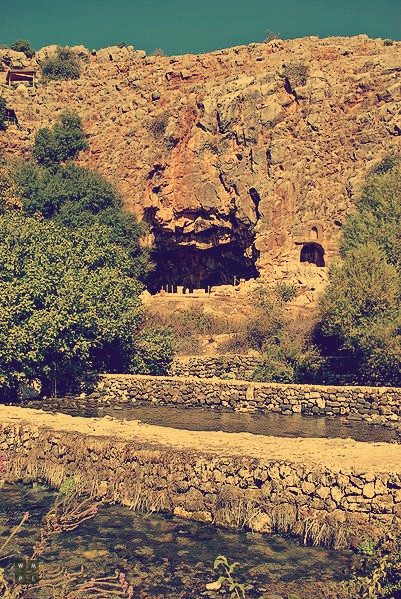I have recently had the spectacular privilege of visiting the Holy Land. On one fine day our pilgrim group journeyed to the ruins of Caesarea Philippi, once the administrative center of Philip the Tetrarch. Philip was the son of Herod the Great, who ordered the massacre of Bethlehem’s innocents, and half-brother to Herod Antipas, who presided over the crucifixion of Jesus and the martyrdom of John – an illustrious family.
Here, in Caesarea Philippi, Jesus made Peter the Rock. Here he promised “the keys of the kingdom,” connecting gospel pronouncements on earth with gospel guarantees in heaven. Here Jesus promised to build his church. The apostolic mission of God was envisioned in Caesarea Philippi, the mission that carries us into the world still today: Jesus will build his church; he will enlist his disciples in the task; he will make the authority of heaven stand behind them. And the powers of death, all hell itself, cannot undo the endeavor (Matthew 16:13-20; cf. Mark 8:27-30, Luke 9:18-21).

Why here? I wondered.
Caesarea Philippi is the site of a geological curiosity that has attracted visitors for centuries – a remarkable cave in a sheer rock wall that is considered the source of the River Jordan. The place is positively dripping with significance for the people of Israel. No river is more important for the imagination of the Jewish nation.
Here is the site of an ancient temple dedicated to the Greek god, Pan – the god of victory in battle, hunting, herding, music, and related activities. It was said that Pan himself was born in that remarkable cave. Few places were as significant for enthusiasts of the Greek pantheon.
Ba’al was worshiped here before the Greeks arrived on the scene. Archeologists have identified 14 pagan temples, I am told, in the immediate area. Ba’al worshippers were impressed with the cave and its waters, too.
And here Herod the Great worshipped Caesar the Emperor. Herod erected a temple dedicated to his lord, demonstrating his personal devotion. He called the place Caesarea. His son Philip beautified the temple further, and in a sign of devotion added his name to the place, as well.
The Holy Land is full of holy places of many kinds and varieties, that’s for sure. But there are few places with more layers of religiosity than Caesarea Philippi. So why here? Precisely because of this multi-layered, highly-charged religious backdrop, I suppose.
It was precisely here that Jesus queried his disciples, “Who do you say that I am?” (Matthew 16:15) – and here that Peter famously replied, “You are the Messiah, the Son of the living God” (Mt. 16:16). Jesus stood his disciples over and against this specific backdrop and asked them, in a sense, to pronounce themselves. What did they see in Jesus? Was he their Sovereign? Was he King?
The apostolic mission of God – building the church with “rocks” like Peter – gets real against the contrasting backdrop of Ba’al and Pan, or our favorite cultural icons and national deities. Jesus gathered his disciples here, not in some quiet classroom or vacation spot. Peter is no “rock” – until he finds in Jesus his King. God is our rock, after all (2 Samuel 22:3, 32, 47) – not any human being. Peter becomes building material when he rests on the Rock who is Jesus (cf. 1 Corinthians 10:4).
In this month’s issue of Together in Prayer you will find stories from Mongolia and The Islands, and prayer requests from here and there around the world. In places like these, you might find backdrops similar to the holy places of Caesarea Philippi. I have seen them: shrine places festooned with colorful amulets and offerings, dedicated to the powerful “spirits” of the land; holy places dedicated to saints and miracle workers, and so on. You can imagine Jesus standing before places like these, looking us in the eye, and asking, “Who do you say that I am?”
But you don’t need to travel to the steppes of Mongolia to find backdrops similar to Pan’s holy cave. In every human heart there is a “Caesarea Philippi” and an altar to some old Pan. It may be a pet ideology, some personal bandwagon – or wealth, prestige, comfort, security, or the path to upward mobility. It may be our children. It may be our careers. These are the reasons the ancients were attracted to places like Caesarea Philippi and their “gods.” They still attract our homage.
In the grotto of every human heart a decision will be faced. What will we make of Jesus? Will we see in him our King?
Who is Jesus for you?
We were at the same site. It was a wonderful experience as you so well describe